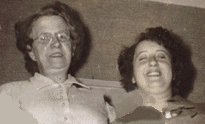

 Elisabeth, called Elly by family and friends, was eleven years old in
1942 when she went into hiding with her parents and her older brother Henry. Elly had been attending the Jewish Secondary School in Amsterdam, a development which
was the result of full-scale segregation of Dutch Jews in all public
accommodations since the start of the Nazi occupation of Holland in 1940.
There was another Jewish girl who was attending the same school as Elly.
Her name was Anne
Frank. The world would come to know her story of courage and kindness
through her diary, which was found and published after she died of typhus
in Bergen-Belsen in March of 1945. Elly's story is very similar except for
the ending. Elisabeth, called Elly by family and friends, was eleven years old in
1942 when she went into hiding with her parents and her older brother Henry. Elly had been attending the Jewish Secondary School in Amsterdam, a development which
was the result of full-scale segregation of Dutch Jews in all public
accommodations since the start of the Nazi occupation of Holland in 1940.
There was another Jewish girl who was attending the same school as Elly.
Her name was Anne
Frank. The world would come to know her story of courage and kindness
through her diary, which was found and published after she died of typhus
in Bergen-Belsen in March of 1945. Elly's story is very similar except for
the ending. |
|
By 1943, round-ups, arrests and mass deportations of Jews in Amsterdam has become commonplace. Elly's father, Abraham Rodrigues, made the decision to go into hiding to avoid capture by the Nazi occupiers. Their first hiding place was an attic that they shared with another Jewish family. The Rodrigues family shared this attic of two rooms for eleven months. During their stay here, the children could not move from 8:00 in the morning until 5: 00 in the afternoon for fear of being discovered by passers-by and those who used the building for business. Jews could be turned in to the Gestapo for scarce wartime goods such as bread and cigarettes and money. During the silent time, Elly's mother offered school lessons, and the children played games to keep their minds occupied. It was the goal of the parents to create an atmosphere of normality for the children to the greatest extent possible under these trying conditions. |
Elly's father had received word that their hiding place was about to be discovered. The family made a daring midnight transfer to the new hiding place, which would turn out to be the first of many in the coming months. They travelled by hearse, which was one of the vehicle types the Nazis did not interfere with. The other was the ambulance.
By the winter 1943, Abraham Rodrigues made the decision to stop running. With the help of business contacts and the Dutch underground, Abraham left his daughter with a school teacher
 |
Elly and her foster mother, Grietje "Grace" Bogaarts, ca. 1958. |
Abraham made numerous trips to the village to supply Grace with falsified documents to support Elly. In the early months of 1944, Elly's parents had been betrayed and arrested. With Elly vulnerable and no source of support, Grace decided to take Elly into hiding in the Northern coast of Holland. they spent the next six weeks in another a ttic together, sharing their food, space, and their faith. Months later, Grace was given the word that returning to her own village would calm suspicions and constitute the safest move. So they returned in the fall of 1944. The villagers later revealed th at they suspected Elly of being Jewish, but they refused to betray their fellow Dutch citizens and human beings.
 Elly and
her brother were able to come out of hiding, but she would never see her
parents again. In 1960, the International Red Cross notified Elly that her parents had been
gassed in Auschwitz. Grace became Elly's legal guardian at the end of the
war in 1945, and they continued a relationship that lasted until her death
in 1964. In 1983, when the names for the Wall of the Rescuers were being
collected, Elly submitted the name of her foster mother, Grace "Grietje"
Bogaarts, to the United States Holocaust Memorial Museum committee as one
of the righteous gentiles who protected Europe's Jews during World War II.
(My first daughter was named after this woman who demonstrated the best
God-given traits of human nature. When I see Grace, I see the miracle of
life that was given to my mother through her namesake, Grace "Grietje"
Bogaarts.)
Elly and
her brother were able to come out of hiding, but she would never see her
parents again. In 1960, the International Red Cross notified Elly that her parents had been
gassed in Auschwitz. Grace became Elly's legal guardian at the end of the
war in 1945, and they continued a relationship that lasted until her death
in 1964. In 1983, when the names for the Wall of the Rescuers were being
collected, Elly submitted the name of her foster mother, Grace "Grietje"
Bogaarts, to the United States Holocaust Memorial Museum committee as one
of the righteous gentiles who protected Europe's Jews during World War II.
(My first daughter was named after this woman who demonstrated the best
God-given traits of human nature. When I see Grace, I see the miracle of
life that was given to my mother through her namesake, Grace "Grietje"
Bogaarts.)
The story, of course, does not end here. To find out how Elisabeth met Ernest, read the epilogue. But first, learn about the experiences of Elly's husband, Ernest H. Cassutto.
To The Ernest Cassutto Story |
To The Cassutto Memorial Page |
To Mr Cassutto's Personal Page |
To The NHHS Main Page |